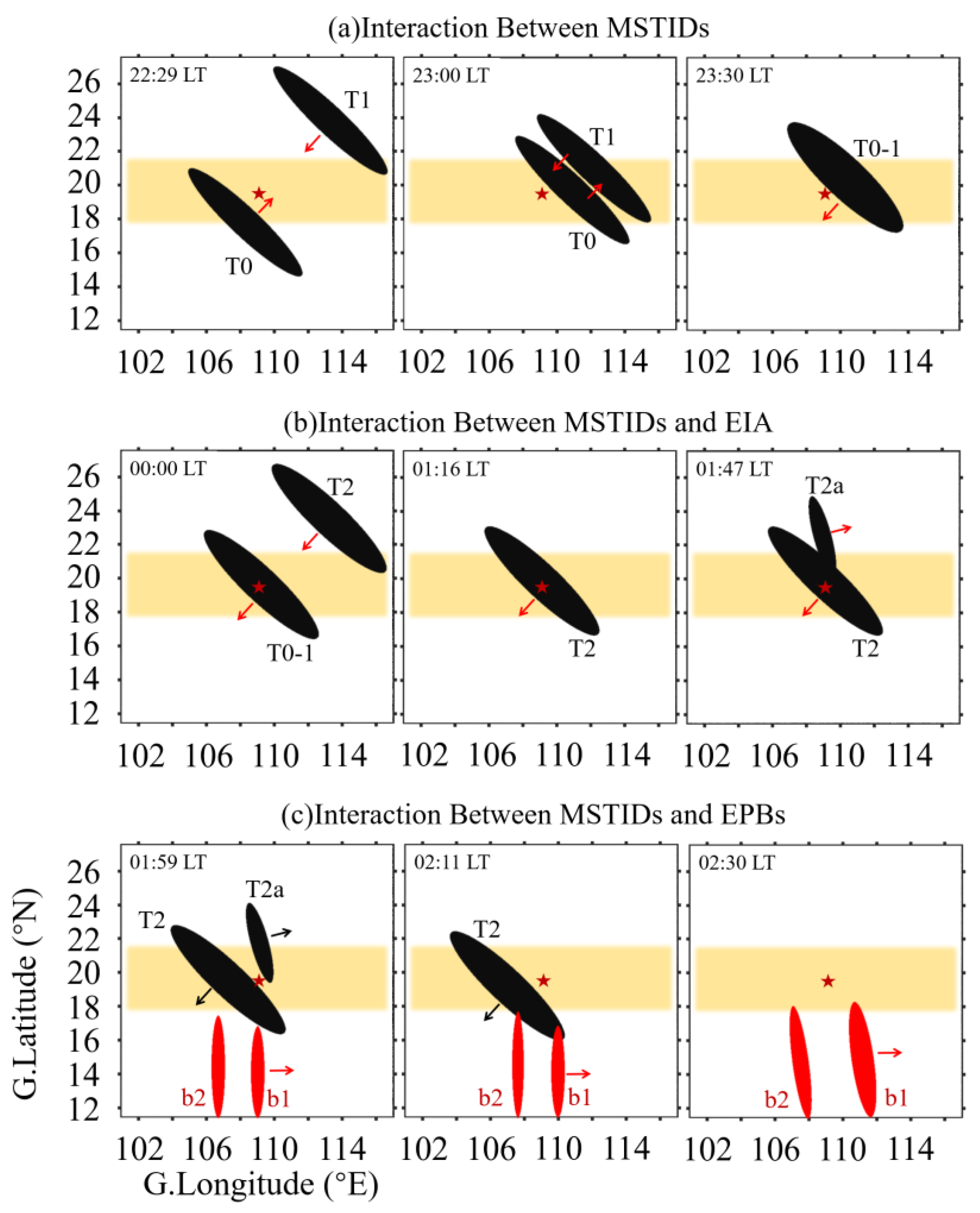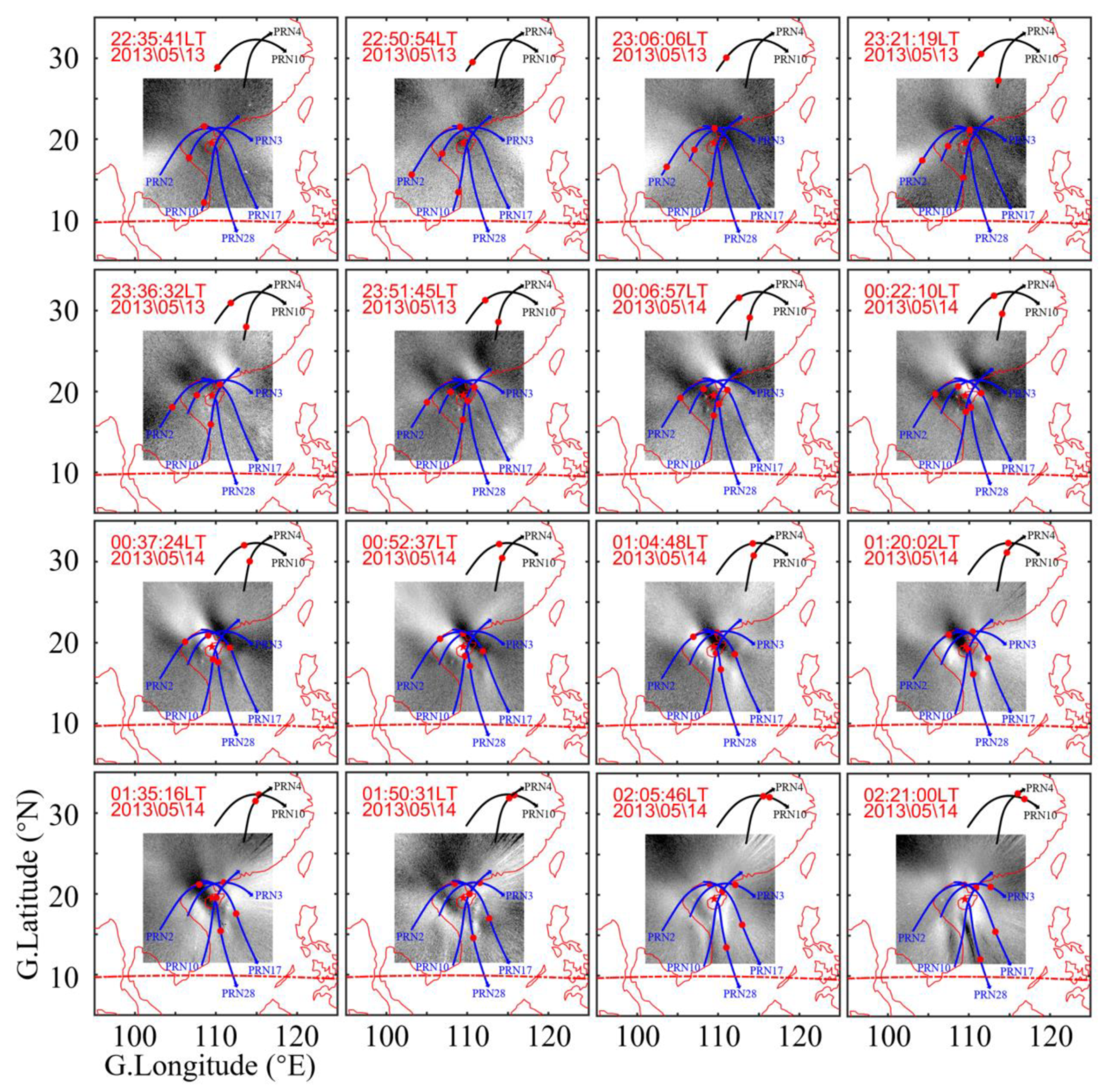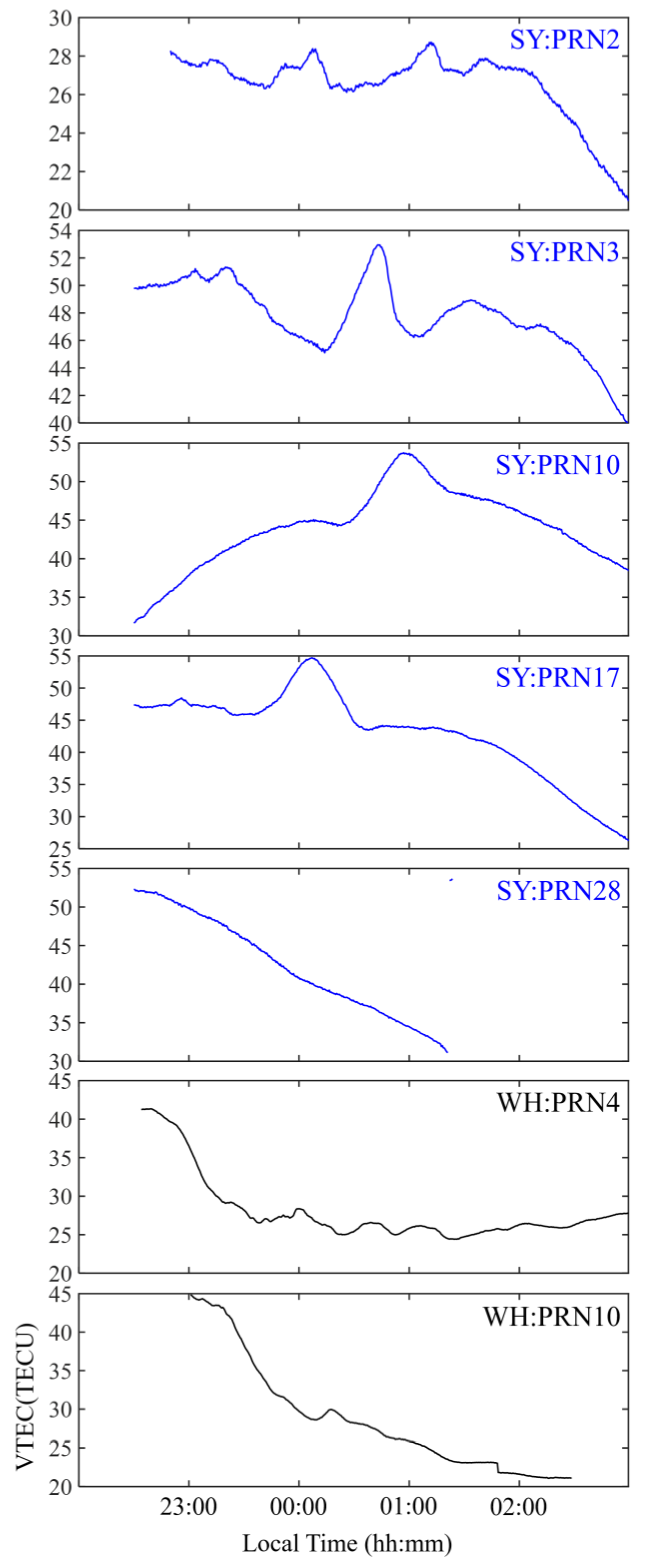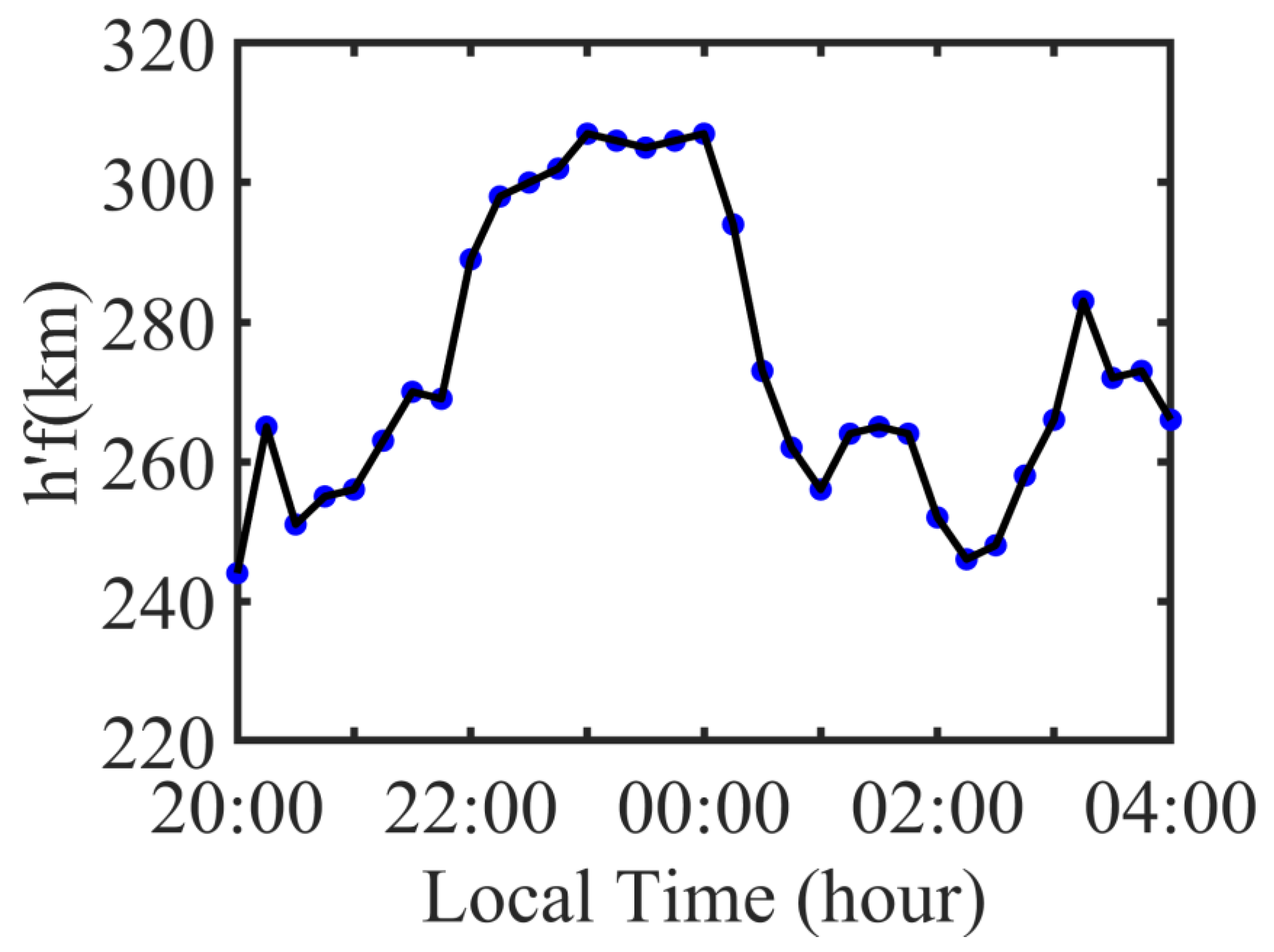Interactions between MSTIDs and Ionospheric Irregularities in the Equatorial Region Observed on 13–14 May 2013
Abstract
:1. Introduction
2. Materials and Methods
3. Results
4. Discussion
4.1. The Interaction between MSTIDs and the EIA
4.2. The Interaction between MSTIDs and EPBs
5. Conclusions
Supplementary Materials
Author Contributions
Funding
Data Availability Statement
Acknowledgments
Conflicts of Interest
References
- Perkins, F. Spread F and ionospheric currents. J. Geophys. Res. 1973, 78, 218–226. [Google Scholar] [CrossRef]
- Hocke, K.; Schlegel, K. A review of atmospheric gravity waves and traveling ionospheric disturbances: 1982–1995. Ann. Geo-Phys. 1996, 9, 917–940. [Google Scholar] [CrossRef]
- Fritts, D.C.; Abdu, M.A.; Batista, B.R.; Batista, I.S.; Batista, P.P.; Buriti, R.; Clemesha, B.R.; Dautermann, T.; de Paula, E.R.; Fechine, B.J.; et al. Overview and summary of the Spread F Experi-ment (SpreadFEx). Ann. Geophys. 2009, 27, 2141–2155. [Google Scholar] [CrossRef]
- Mendillo, M.; Baumgardner, J.; Nottingham, D.; Aarons, J.; Reinisch, B.; Scali, J.; Kelley, M. Investigations of thermospheric-ionospheric dynamics with 6300-Å images from the Arecibo Observatory. J. Geophys. Res. Space Phys. 1997, 102, 7331–7343. [Google Scholar] [CrossRef]
- Martinis, C.; Baumgardner, J.; Wroten, J.; Mendillo, M. Seasonal dependence of MSTIDs obtained from 630.0 nm airglow imaging at Arecibo. Geophys. Res. Lett. 2010, 37, L11103. [Google Scholar] [CrossRef]
- Garcia, F.J.; Kelley, M.C.; Makela, J.J.; Huang, C.-S. Airglow observations of mesoscale low velocity traveling ionospheric disturbances at midlatitudes. J. Geophys. Res. 2000, 105, 415. [Google Scholar] [CrossRef]
- Otsuka, Y.; Shiokawa, K.; Ogawa, T.; Wilkinson, P. Geomagnetic conjugate observations of medium-scale traveling ionospheric disturbances at midlatitude using all-sky airglow imagers. Geophys. Res. Lett. 2004, 31, L15803. [Google Scholar] [CrossRef]
- Shiokawa, K.; Otsuka, Y.; Tsugawa, T.; Ogawa, T.; Saito, A.; Ohshima, K.; Kubota, M.; Maruyama, T.; Nakamura, T.; Yamamoto, M.; et al. Geomagnetic conjugate observation of nighttime medium-scale and large-scale traveling ionospheric disturbances: FRONT3 campaign. J. Geophys. Res. 2005, 110, A05303. [Google Scholar] [CrossRef]
- Shiokawa, K.; Ihara, C.; Otsuka, Y.; Ogawa, T. Statistical study of nighttime medium-scale traveling ionospheric disturbances using midlatitude airglow images. J. Geophys. Res. 2003, 108, 1052. [Google Scholar] [CrossRef]
- Fukushima, D.; Shiokawa, K.; Otsuka, Y.; Ogawa, T. Observation of equatorial nighttime medium-scale traveling ionospheric disturbances in 630-nm airglow images over 7 years. J. Geophys. Res. 2012, 117, A10324. [Google Scholar] [CrossRef]
- Makela, J.J.; Miller, E.S.; Talaat, E.R. Nighttime medium-scale traveling ionospheric disturbances at low geomagnetic latitudes. Geophys. Res. Lett. 2010, 37, 163–175. [Google Scholar] [CrossRef]
- Shiokawa, K.; Otsuka, Y.; Ejiri, M.K.; Sahai, Y.; Kadota, T.; Ihara, C.; Ogawa, T.; Igarashi, K.; Miyazaki, S.; Saito, A. Imaging observations of the equatorward limit of midlatitude traveling ionospheric distrubances. Earth Planets Space 2002, 54, 57–62. [Google Scholar] [CrossRef]
- Appleton, E.V. Two anomalies in the ionosphere. Nature 1946, 157, 691. [Google Scholar] [CrossRef]
- Croom, S.; Robbins, A.; Thomas, J.O. Two anomalies in the behaviour of the F2 layer of the ionosphere. Nature 1959, 184, 2003–2004. [Google Scholar] [CrossRef]
- Balan, N.; Liu, L.; Le, H. A brief review of equatorial ionization anomaly and ionospheric irregularities. Earth Planet. Phys. 2018, 2, 257–275. [Google Scholar] [CrossRef]
- Duncan, R.A. The equatorial f-region of the ionosphere. J. Atmos. Terr. Phys. 1960, 18, 89–100. [Google Scholar] [CrossRef]
- Kelley, M.C. The Earth’s Ionosphere: Plasma Physics and Electrodynamics; Academic Press: Cambridge, MA, USA, 2009. [Google Scholar]
- Makela, J.J.; Otsuka, Y. Overview of nighttime ionospheric instabilities at low- and mid-latitudes: Coupling aspects resulting in structuring at the mesoscale. Space Sci. Rev. 2012, 168, 419–440. [Google Scholar] [CrossRef]
- Wu, K.; Xu, J.; Yue, X.; Xiong, C.; Ji, L.; Yuan, W.; Wang, C.; Zhu, Y.; Luo, J. Equatorial plasma bubbles developing around sunrise observed by an all-sky imager and global navigation satellite system network during the storm time. Ann. Geophys. 2020, 38, 163–177. [Google Scholar] [CrossRef]
- Taylor, M.J.; Eccles, J.V.; Labelle, J.; Sobral, J. High resolution oi (630 nm) image measurements of f-region depletion drifts during the guará campaign. Geophys. Res. Lett. 2013, 24, 1699–1702. [Google Scholar] [CrossRef]
- Martinis, C.; Eccles, J.V.; Baumgardner, J.; Manzano, J.; Mendillo, M. Latitude dependence of zonal plasma drifts obtained from dual-site airglow observations. J. Geophys. Res. 2003, 108, 1129. [Google Scholar] [CrossRef]
- Park, S.H.; England, S.L.; Immel, T.J.; Frey, H.U.; Mende, S.B. A method for determining the drift velocity of plasma depletions in the equatorial ionosphere using far-ultraviolet spacecraft observations. J. Geophys. Res. 2007, 112, A11314. [Google Scholar] [CrossRef]
- Weber, E.J.; Buchau, J.; Eather, R.H.; Mende, S.B. North-south aligned equatorial airglow depletions. J. Geophys. Res. 1978, 83, 712–716. [Google Scholar] [CrossRef]
- Mendillo, M.; Baumgardner, J. Airglow characteristics of equatorial plasma depletions. J. Geophys. Res. 1982, 87, 7641–7652. [Google Scholar] [CrossRef]
- Mendillo, M.; Tyler, A. Geometry of depleted plasma regions in the equatorial ionosphere. J. Geophys. Res. 1983, 88, 5778–5782. [Google Scholar] [CrossRef]
- Kil, H.; DeMajistre, R.; Paxton, L.J.; Zhang, Y. Nighttime F-region morphology in the low and middle latitudes seen from DMSP F15 and TIMED/GUVI. J. Atmos. Sol. Terr. Phys. 2006, 68, 1672–1682. [Google Scholar] [CrossRef]
- Suzuki, S.; Hosokawa, K.; Otsuka, Y.; Shiokawa, K.; Ogawa, T.; Nishitani, N.; Shevtsov, B.M. Coordinated observations of night-time medium-scale traveling ionospheric disturbances in 630-nm airglow and HF radar echoes at midlatitudes. J. Geophys. Res. 2009, 114, A07312. [Google Scholar] [CrossRef]
- Basu, S.; Huba, J.; Krall, J.; Mcdonald, S.E.; Makela, J.J.; Miller, E.S.; Ray, S.; Groves, K. Day-to-day variability of the equatorial ionization anomaly and scintillations at dusk observed by guvi and modeling by sami3. J. Geophys. Res. Space Phys. 2009, 114, A04302. [Google Scholar] [CrossRef]
- Dang, T.; Luan, X.; Lei, J.; Dou, X.; Wan, W. A numerical study of the interhemispheric asymmetry of the equatorial ionization anomaly in solstice at solar minimum. J. Geophys. Res. Space Phys. 2016, 121, 9099–9110. [Google Scholar] [CrossRef]
- Kil, H.; Paxton, L.J. Global distribution of nighttime medium-scale traveling ionospheric disturbances seen by Swarm satellites. Geophys. Res. Lett. 2017, 44, 9176–9182. [Google Scholar] [CrossRef]
- Martinis, C.; Baumgardner, J.; Wroten, J.; Mendillo, M. All-sky-imaging capabilities for ionospheric space weather research using geomagnetic conjugate point observing sites. Adv. Space Res. 2017, 61, 1636–1651. [Google Scholar] [CrossRef]
- Xiong, C.; Xu, J.; Wu, K.; Wei, Y. Longitudinal thin structure of equatorial plasma depletions coincidently observed by swarm constellation and all-sky imager. J. Geophys. Res. Space Phys. 2018, 123, 1593–1602. [Google Scholar] [CrossRef]
- Huang, F.; Lei, J.; Dou, X.; Luan, X.; Zhong, J. Nighttime medium-scale traveling ionospheric disturbances from airglow imager and Global Navigation Satellite Systems observations. Geophys. Res. Lett. 2018, 45, 31–38. [Google Scholar] [CrossRef]
- Khadka, S.M.; Valladares, C.E.; Sheehan, R.; Gerrard, A.J. Effects of electric field and neutral wind on the asymmetry of equatorial ionization anomaly. Radio Sci. 2018, 53, 683–697. [Google Scholar] [CrossRef]
- Balan, N.; Bailey, G.J.; Abdu, M.A.; Oyama, K.I.; Richards, P.G.; MacDougall, J.; Batista, I.S. Equatorial plasma fountain and its effects over three locations: Evidence for an additional layer, the F 3 layer. J. Geophys. Res. 1997, 102, 2047–2056. [Google Scholar] [CrossRef]
- Cai, X.; Qian, L.; Wang, W.; McInerney, J.M.; Liu, H.-L.; Eastes, R.W. Investigation of the post-sunset extra electron density peak poleward of the equatorial ionization anomaly southern crest. J. Geophys. Res. Space Phys. 2022, 127, e2022JA030755. [Google Scholar] [CrossRef]
- Wu, K.; Qian, L.; Wang, W.; Cai, X.; Mclnerney, J.M. Investigation of the GOLD observed merged nighttime EIA with WACCM-X simulations during the storm of 3 and 4 November 2021. Geophys. Res. Lett. 2023, 50, e2023GL103603. [Google Scholar] [CrossRef]
- Wu, K.; Xu, J.; Wang, W.; Sun, L.; Yuan, W. Interaction of oppositely traveling medium-scale traveling ionospheric disturbances observed in low latitudes during geomagnetically quiet nighttime. J. Geophys. Res. Space Phys. 2021, 126, e2020JA028723. [Google Scholar] [CrossRef]
- Aa, E.; Zhang, S.-R.; Wang, W.; Erickson, P.J.; Qian, L.; Eastes, R.; Harding, B.J.; Immel, T.J.; Karan, D.K.; Daniell, R.E.; et al. Pronounced suppression and X-pattern merging of equatorial ionization anomalies after the 2022 Tonga volcano eruption. J. Geophys. Res. Space Phys. 2022, 127, e2022JA030527. [Google Scholar] [CrossRef]
- Miller, E.S.; Makela, J.J.; Kelley, M.C. Seeding of equatorial plasma depletions by polarization electric fields from middle latitudes: Experimental evidence. Geophys. Res. Lett. 2009, 36, L18105. [Google Scholar] [CrossRef]
- Krall, J.; Huba, J.D.; Ossakow, S.L.; Joyce, G.; Makela, J.J.; Miller, E.S.; Kelley, M.C. Modeling of equatorial plasma bubbles triggered by non-equatorial traveling ionospheric disturbances. Geophys. Res. Lett. 2011, 38, L08103. [Google Scholar] [CrossRef]
- Otsuka, Y.; Shiokawa, K.; Ogawa, T. Disappearance of equatorial plasma bubble after interaction with mid-latitude medium-scale traveling ionospheric disturbance. Geophys. Res. Lett. 2012, 39, 14105. [Google Scholar] [CrossRef]
- Balan, N.; Souza, J.; Bailey, G.J. Recent developments in the understanding of equatorial ionization anomaly: A review. J. Atmos. Sol. Terr. Phys. 2018, 171, 3–11. [Google Scholar] [CrossRef]
- Narayanan, V.L.; Shiokawa, K.; Otsuka, Y.; Saito, S. Airglow observations of nighttime medium-scale traveling ionospheric disturbances from Yonaguni: Statistical characteristics and low-latitude limit. J. Geophys. Res. Space Phys. 2014, 119, 9268–9282. [Google Scholar] [CrossRef]
- Rathi, R.; Yadav, V.; Mondal, S.; Sarkhel, S.; Sunil Krishna, M.V.; Upadhayaya, A.K.; Kannaujiya, S.; Chauhan, P. A case study on the interaction between MSTIDs’ fronts, their dissipation, and a curious case of MSTID’s rotation over geomagnetic low-mid latitude transition region. J. Geophys. Res. Space Phys. 2022, 127, e2021JA029872. [Google Scholar] [CrossRef]
- Lai, C.; Xu, J.; Lin, Z.; Wu, K.; Zhang, D.; Li, Q.; Zhu, Y. Statistical Characteristics of Nighttime Medium-Scale Traveling Ionospheric Disturbances from 10-Years of Airglow Observation by the Machine Learning Method. Space Weather 2023, 21, e2023SW003430. [Google Scholar] [CrossRef]
- Wu, K.; Xu, J.; Wang, W.; Yuan, W. Morphology and evolution of plasma density enhancement events in the equatorial ionospheric F region on 8 February and 4 November 2018. J. Geophys. Res. Space Phys. 2022, 127, e2022JA030482. [Google Scholar] [CrossRef]
- Jiang, C.; Wei, L.; Yokoyama, T.; Xu, J.; Wu, K.; Yuan, W.; Zhao, Z. Upwelling coherent backscatter plumes observed with ionosondes in low-latitude region. J. Space Weather Space Clim. 2022, 12, 13. [Google Scholar] [CrossRef]
- Sun, L.; Xu, J.; Zhu, Y.; Xiong, C.; Yuan, W.; Wu, K.; Hao, Y.; Chen, G.; Yan, C.; Wang, Z.; et al. Interaction between an EMSTID and an EPB in the EIA crest region over China. J. Geophys. Res. Space Phys. 2021, 126, e2020JA029005. [Google Scholar] [CrossRef]
- Garcia, F.J.; Taylor, M.J.; Kelley, M.C. Two-dimensional spectral analysis of mesospheric airglow image data. Appl. Opt. 1997, 36, 7374–7385. [Google Scholar] [CrossRef]
- Sivakandan, M.; Chakrabarty, D.; Ramkumar, T.K.; Guharay, A.; Taori, A.; Parihar, N. Evidence for deep ingression of the midlatitude MSTID into as low as ∼3.5° magnetic latitude. J. Geophys. Res. Space Phys. 2019, 124, 749–764. [Google Scholar] [CrossRef]
- Ogawa, T.; Nishitani, N.; Otsuka, Y.; Shiokawa, K.; Tsugawa, T.; Hosokawa, K. Medium-scale traveling ionospheric disturbances observed with the SuperDARN Hokkaido radar, all-sky imager, and GPS network and their relation to concurrent sporadic E irregularities. J. Geophys. Res. 2009, 114, A03316. [Google Scholar] [CrossRef]
- Kelley, M.C.; Makela, J.J.; Swartz, W.E.; Collins, S.C.; Thonnard, S.; Aponte, N.; Tepley, C.A. Caribbean ionosphere campaign, year one: Airglow and plasma observations during two intense mid-latitude spread-F events. Geophys. Res. Lett. 2000, 27, 2825–2828. [Google Scholar] [CrossRef]
- Shiokawa, K.; Otsuka, Y.; Ihara, C.; Ogawa, T.; Rich, F.J. Ground and satellite observations of nighttime medium-scale traveling ionospheric disturbance at midlatitude. J. Geophys. Res. Space Phys. 2003, 108, 145. [Google Scholar] [CrossRef]
- Sun, L.; Xu, J.; Xiong, C.; Zhu, Y.; Yuan, W.; Hu, L.; Liu, W.; Chen, G. Midlatitudinal special airglow structures generated by the interaction between propagating medium-scale traveling ionospheric disturbance and nighttime plasma density enhancement at magnetically quiet time. Geophys. Res. Lett. 2019, 46, 1158–1167. [Google Scholar] [CrossRef]
- Kelley, M.C.; Makela, J.J.; Saito, A.; Aponte, N.; Sulzer, M.; González, S.A. On the electrical structure of airglow depletion/height layer bands over Arecibo. Geophys. Res. Lett. 2000, 27, 2837–2840. [Google Scholar] [CrossRef]
- Kelley, M.C.; Makela, J.J. Resolution of the discrepancy between experiment and theory of midlatitude F-region structures. Geophys. Res. Lett. 2001, 28, 2589–2592. [Google Scholar] [CrossRef]
- Wrasse, C.M.; Figueiredo, C.A.d.O.B.; Barros, D.; Takahashi, H.; Carrasco, A.J.; Vital, L.F.R.; Resende, L.C.A.; Egito, F.; Rosa, G.d.M.; Sampaio, A.H.R. Interaction between Equatorial Plasma Bubbles and a Medium-Scale Traveling Ionospheric Disturbance, observed by OI 630 nm airglow imaging at Bom Jesus de Lapa, Brazil. Earth Planet. Phys. 2021, 5, 397–406. [Google Scholar] [CrossRef]
- Weber, E.J.; Basu, S.; Bullett, T.W.; Valladares, C.; Bishop, G.; Groves, K.; Kuenzler, H.; Ning, P.; Sultan, P.J.; Sheehan, R.E.; et al. Equatorial plasma depletion precursor signature and onset observed at 11° south of the magnetic equator. J. Geophys. Res. 1996, 101, 26829–26838. [Google Scholar] [CrossRef]
- Aggson, T.L.; Laakso, H.; Maynard, N.C.; Pfaff, R.F. In situ observations of bifurcation of equatorial ionospheric plasma depletions. J. Geophys. Res. 1996, 101, 5125–5132. [Google Scholar] [CrossRef]
- Carrasco, A.J.; Pimenta, A.A.; Wrasse, C.M.; Batista, I.S.; Takahashi, H. Why do equatorial plasma bubbles bifurcate? J. Geophys. Res. Space Phys. 2020, 125, e2020JA028609. [Google Scholar] [CrossRef]
- Xie, H.; Li, G.; Zhao, X.; Ding, F.; Yan, C.; Yang, G.; Ning, B. Coupling between E region quasi-periodic echoes and F region medium-scale traveling ionospheric disturbances at low latitudes. J. Geophys. Res. Space Phys. 2020, 123, e2019JA027720. [Google Scholar] [CrossRef]
- Hunsucker, R.D. Atmospheric gravity waves generated in the high-latitude ionosphere: A review. Rev. Geophys. 1982, 20, 293–315. [Google Scholar] [CrossRef]
- Hysell, D.L.; Yokoyama, T.; Nossa, E.; Hedden, R.B.; Larsen, M.F.; Munro, J.; González, S.A. Radar and optical observations of irregular midlatitude sporadic E layers beneath MSTIDs. Aeron. Earth’s Atmos. Ionos. 2011, 2, 269–281. [Google Scholar] [CrossRef]
- Helmboldt, J. A multi-platform investigation of midlatitude sporadic E and its ties to E–F coupling and meteor activity. Ann. Geophys. 2016, 34, 529–541. [Google Scholar] [CrossRef]
- Matsushima, R.; Hosokawa, K.; Sakai, J.; Otsuka, Y.; Ejiri, M.K.; Nishioka, M.; Tsugawa, T. Propagation characteristics of sporadic E and medium-scale traveling ionospheric disturbances (MSTIDs): Statistics using HF Doppler and GPS-TEC data in Japan. Earth Planets Space 2022, 74, 60. [Google Scholar] [CrossRef]
- Yokoyama, T.; Hysell, D.L.; Otsuka, Y.; Yamamoto, M. Three-dimensional simulation of the coupled Perkins and Es-layer instabilities in the nighttime midlatitude ionosphere. J. Geophys. Res. Space Phys. 2009, 114, A03308. [Google Scholar] [CrossRef]
- Yokoyama, T.; Hysell, D.L. A new midlatitude ionosphere electrodynamics coupling model (MIECO): Latitudinal dependence and propagation of medium-scale traveling ionospheric disturbances. Geophys. Res. Lett. 2010, 37, L08105. [Google Scholar] [CrossRef]
- Cosgrove, R.B.; Tsunoda, R.T. Instability of the E-F coupled nighttime midlatitude ionosphere. J. Geophys. Res. 2004, 109, A04305. [Google Scholar] [CrossRef]






Disclaimer/Publisher’s Note: The statements, opinions and data contained in all publications are solely those of the individual author(s) and contributor(s) and not of MDPI and/or the editor(s). MDPI and/or the editor(s) disclaim responsibility for any injury to people or property resulting from any ideas, methods, instructions or products referred to in the content. |
© 2024 by the authors. Licensee MDPI, Basel, Switzerland. This article is an open access article distributed under the terms and conditions of the Creative Commons Attribution (CC BY) license (https://creativecommons.org/licenses/by/4.0/).
Share and Cite
Wu, K.; Qian, L. Interactions between MSTIDs and Ionospheric Irregularities in the Equatorial Region Observed on 13–14 May 2013. Remote Sens. 2024, 16, 2413. https://doi.org/10.3390/rs16132413
Wu K, Qian L. Interactions between MSTIDs and Ionospheric Irregularities in the Equatorial Region Observed on 13–14 May 2013. Remote Sensing. 2024; 16(13):2413. https://doi.org/10.3390/rs16132413
Chicago/Turabian StyleWu, Kun, and Liying Qian. 2024. "Interactions between MSTIDs and Ionospheric Irregularities in the Equatorial Region Observed on 13–14 May 2013" Remote Sensing 16, no. 13: 2413. https://doi.org/10.3390/rs16132413
APA StyleWu, K., & Qian, L. (2024). Interactions between MSTIDs and Ionospheric Irregularities in the Equatorial Region Observed on 13–14 May 2013. Remote Sensing, 16(13), 2413. https://doi.org/10.3390/rs16132413






